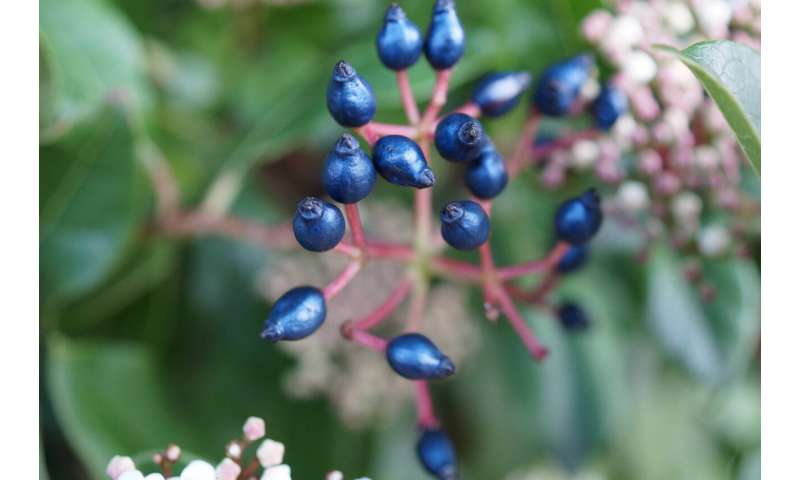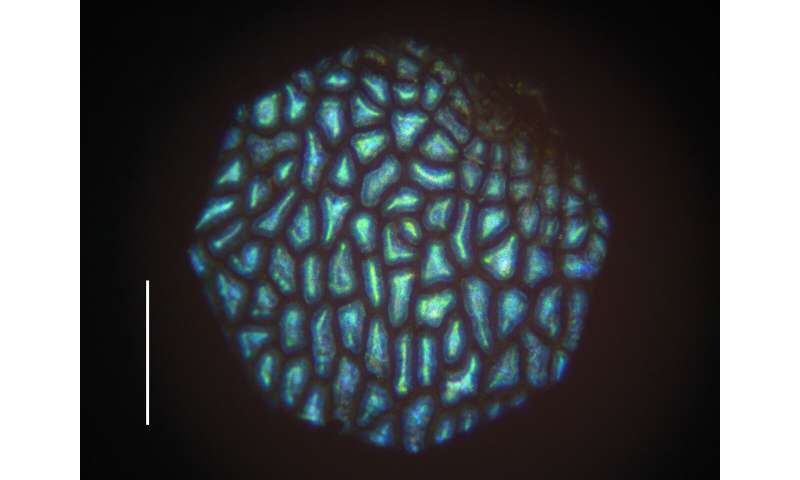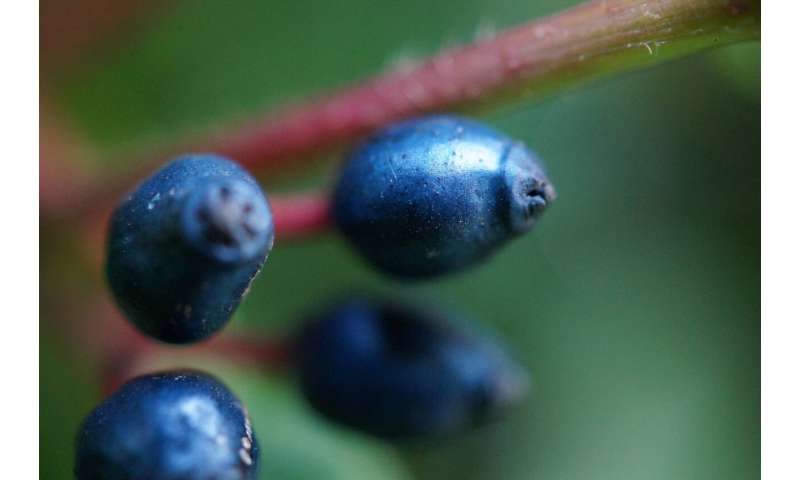
There's a reason why blue fruits are so rare: the pigment compounds that make fruits blue are relatively uncommon in nature. But the metallic blue fruits of Viburnum tinus, a popular landscaping plant in Europe, get their color a different way. Instead of relying solely on pigments, the fruits use structural color to reflect blue light, something that's rarely seen in plants. Researchers reporting August 6 in the journal Current Biology show that the fruits use nanostructures made of lipids in their cell walls, a previously unknown mechanism of structural color, to get their striking blue—which may also double as a signal to birds that the fruits are full of nutritious fats.
"Structural color is very common in animals, especially birds, beetles, and butterflies, but only a handful of plant species have ever been found to have structural color in their fruits," says co-first author Miranda Sinnott-Armstrong, a postdoctoral researcher at the University of Colorado-Boulder. "This means that V. tinus, in addition to showing a completely novel mechanism of structural color, is also one of the few known structurally colored fruits."
Senior author Silvia Vignolini, a physical chemist at the University of Cambridge, has been interested in the plants for nearly 10 years. "I actually found this Viburnum in a garden in Italy and observed that they looked weird, so we measured them at the time but didn't have conclusive results. It was kind of always on the back of my mind," she says. As her team grew, they become more interested in V. tinus and eventually had the capability to examine the structure of the fruits using electron microscopy. "Before we got the images, we were just seeing all these blobs," she says. "When we found out that those blobs were lipids, we got very excited."

While most plants have cell walls made of cellulose, used to make cotton and paper, V. tinus fruit cells have much thicker walls with thousands of globular lipids arranged in layers that reflect blue light. The structure formed by this so-called lipid multilayer allows the fruits to create their vibrant blue color while containing no blue pigment. "This is very strange because globular lipids like these are not usually found in this arrangement in the cell wall, as they are normally stored inside the cell and used for transport," says co-first author Rox Middleton, a physicist who studied the optical response of the fruits during her Ph.D. and is now a postdoctoral researcher at the University of Bristol. "We also believe that this lipid may contribute to the fruit's nutrition. That means that the fruit can demonstrate how nutritious it is by being a beautiful, shiny blue."
This extra nutrition would be important for V. tinus's main consumers: birds that disperse the plant's seeds. Although the researchers can't say for sure whether the lipids are used as fat by the birds that consume them, there is reason to believe they might be. If so, the researchers suggest that the metallic blue color made by the lipid multilayer could indicate to the birds that if they see this striking blue, the fruit in question will have enough nutrients to make it a worthwhile meal. "While birds have been shown to be attracted to blue fruits," says Vignolini, "other blue fruits that we have studied essentially don't have any nutritional value."

Going forward, the researchers want to see how widespread blue structural color is in fruits to understand its ecological significance. They had never seen this type of lipid multilayer in a biomaterial before, but since their discovery, they've begun to take notice of other species. "We actually realize now that there are some older electron microscopy pictures from other plants where you can see the blobs. The researchers didn't know that they were lipids at the time, or that lipids could even form this type of structure, but our research suggests that they very well could be, meaning this structure may not be limited to Viburnum," Vignolini says.
Additionally, learning how V. tinus can use such a unique mechanism to make color may have implications for how we color our own foods. "There are lots of problems connected to food coloration," says Vignolini. She adds that once this mechanism is better understood, it could potentially be used to create a healthier, more sustainable food colorant.
But right now, Vignolini is just excited her initial hunch paid off: "I've been working on this type of photonic structure for quite a while, and I was beginning to think there were no new ways to make it—at some point you've seen so many that you think, 'This is more or less the end, it's going to be difficult to find something new,'" she says. "Instead, we discovered much more than what we expected."
Citation: This fruit attracts birds with an unusual way of making itself metallic blue (2020, August 6) retrieved 6 August 2020 from https://ift.tt/3khGsWc
This document is subject to copyright. Apart from any fair dealing for the purpose of private study or research, no part may be reproduced without the written permission. The content is provided for information purposes only.
"fruit" - Google News
August 06, 2020 at 10:00PM
https://ift.tt/3khGsWc
This fruit attracts birds with an unusual way of making itself metallic blue - Phys.Org
"fruit" - Google News
https://ift.tt/2pWUrc9
https://ift.tt/3aVawBg
Bagikan Berita Ini















0 Response to "This fruit attracts birds with an unusual way of making itself metallic blue - Phys.Org"
Post a Comment